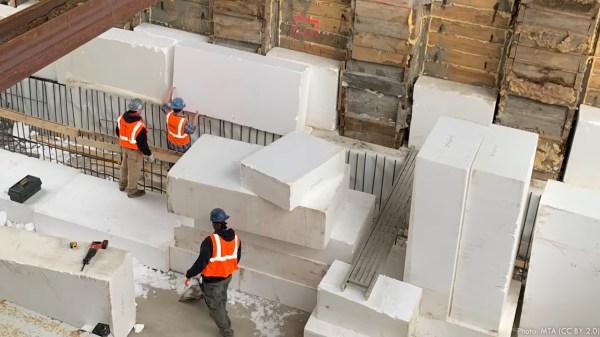We lost a true legend this week with the passing of NASA astronaut Jim Lovell at the ripe old age of 97. Lovell commanded the ill-fated Apollo 13 mission back in 1970, and along with crewmates Jack Swigert and Fred Haise — along with just about every person working at or for NASA — he managed to guide the mortally wounded Odyssey command module safely back home. While he’s rightly remembered for the heroics on 13, it was far from his first space rodeo. Lovell already had two Gemini missions under his belt before Apollo came along, including the grueling Gemini 7, where he and Frank Borman undertook the first long-duration space mission, proving that two men stuffed into a Volkswagen-sized cockpit could avoid killing each other for at least two weeks.
civil engineering10 Articles
Hacking When It Counts: DIY Prosthetics And The Prison Camp Lathe
There are a lot of benefits to writing for Hackaday, but hands down one of the best is getting paid to fall down fascinating rabbit holes. These often — but not always — delightful journeys generally start with chance comments by readers, conversations with fellow writers, or just the random largesse of The Algorithm. Once steered in the right direction, a few mouse clicks are all it takes for the properly prepared mind to lose a few hours chasing down an interesting tale.
I’d like to say that’s exactly how this article came to be, but to be honest, I have no idea where I first heard about the prison camp lathe. I only know that I had a link to a PDF of an article written in 1949, and that was enough to get me going. It was probably a thread I shouldn’t have tugged on, but I’m glad I did because it unraveled into a story not only of mechanical engineering chops winning the day under difficult circumstances, but also of how ingenuity and determination can come together to make the unbearable a little less trying, and how social engineering is an important a skill if you want to survive the unsurvivable.
Continue reading “Hacking When It Counts: DIY Prosthetics And The Prison Camp Lathe”
Mechanisms: Tension Control Bolts
If there’s an enduring image of how large steel structures used to be made, it’s probably the hot riveting process. You’ve probably seen grainy old black-and-white films of a riveting gang — universally men in bib overalls with no more safety equipment than a cigarette, heating rivets to red heat in a forge and tossing them up to the riveters with a pair of tongs. There, the rivet is caught with a metal funnel or even a gloved hand, slipped into a waiting hole in a flange connecting a beam to a column, and beaten into submission by a pair of men with pneumatic hammers.
Dirty, hot, and dangerous though the work was, hot riveted joints were a practical and proven way to join members together in steel structures, and chances are good that any commercial building that dates from before the 1960s or so has at least some riveted joints. But times change and technology marches on, and riveted joints largely fell out of fashion in the construction trades in favor of bolted connections. Riveting crews of three or more men were replaced by a single ironworker making hundreds of predictable and precisely tensioned connections, resulting in better joints at lower costs.
Bolted joints being torqued to specs with an electric wrench might not have the flair of red-hot rivets flying around the job site, but they certainly have a lot of engineering behind them. And as it turns out, the secret to turning bolting into a one-person job is mostly in the bolt itself.
Bridging The Gap Between Dissimilar Road Types With Foam
When you think of driving up or down an embankment, do you ever wonder how much foam you’re currently driving on? Probably not, because it hardly seems like a suitable building material. But as explained by [Practical Engineering] in the video below the break, using an expanded material to backfill an embankment isn’t as dense as it sounds.
In many different disciplines, mating dissimilar materials can be difficult: Stretchy to Firm; Soft to Hard; Light to Heavy. It’s that last one, Light to Heavy, that is a difficult match for roadways. A bridge may be set down in bedrock, but the embankments approaching it won’t be. The result? Over time, embankment settles lower than the bridge does, causing distress for cars and motorists alike. What’s the solution?
To mitigate this, engineers have started to employ less dirty materials to build their otherwise soil based embankments. Lightweight concrete is one solution, but another is Expanded Polystyrene (EPS) foam. Its light weight makes installation simple in anything but a strong breeze, and it’s inexpensive and durable. When used properly, it can last many years and provide a stable embankment that won’t settle as far or as quickly as one made of dirt. Because as it turns out, dirt is heavy. Who knew?
Aside from roadways and bespoke aircraft, EPS foam has also been used for making home insulation. What’s your favorite use for EPS foam? Let us know in the comments below.
Continue reading “Bridging The Gap Between Dissimilar Road Types With Foam”
Building Bridges In This Week’s Hack Chat
In the electronics world, even for the hobbyists, things have only gotten smaller over the years. We went from through-hole components to surface mount, and now we’re at the point where the experienced DIYers are coming around to the idea of using ball grid array (BGA) components in their designs. We’d wonder what things are going to look like in another couple decades, but frankly, it gives us the heebie-jeebies.
So while we’re pretty well versed these days in the hows and whys of tiny things, we see comparatively little large-scale engineering projects. Which is why we were excited to have Andy Oliver stop by this week for the Heavy Engineering Hack Chat. His day job sees him designing and inspecting the control systems for movable bridges — or what many would colloquially refer to as drawbridges.
Now you might think there’s not a lot of demand for this particular skill set, but we’re willing to bet there’s a lot more of these bridges out there than you realized. Andy kicked things off with the revelation that just between the states of Florida and Louisiana, there are about 200 movable bridges of various sizes. On a larger scale, he points out that BridgeHunter.com lists an incredible 3,166 movable bridges in their database, though admittedly many of those are historical and no longer standing. (There really is a site for everything!)

There’s also a huge incentive to keep the existing bridges functioning for as long as possible — building a new one these days could cost hundreds of millions of dollars. Instead, repairs and upgrades are the name of the game. Andy says that if it’s properly maintained, you should get about a century out of a good bridge.
It will probably come as little surprise to find that keeping things as simple as possible is key to making sure a movable bridge can withstand the test of time. While we might imagine that all sorts of high-tech automation systems are at work, and they probably would be if any of us were in charge, Andy says that most of the time it’s old school relay logic.
Even controlling the speed of motors is often down to using beefy relays to switch some additional resistance into the circuit. But when reliability and ease of repair are top priorities, who’s to argue against a classic? Andy recalled a time when a government client made it clear that the only tool you should need to maintain a particular bridge’s control system was a hammer.
Of course, when moving around a million pounds of steel, there’s more than just electrical considerations at play. You’ve also got to take into account things like wind forces on the bridge, specifically that your gears and motors can handle the extra load without tearing themselves apart. The bridge also needs an emergency stop system that can arrest movement at a moment’s notice, but not damage anything in the process.
A lot of fascinating details about these motorized behemoths were covered in the Chat, so we’d invite anyone who’s ever watched a bridge slowly reconfigure itself to peruse through the full transcript. Special thanks to Andy Oliver for stopping by and sharing some of the details about his unique career with the community, and remember that if you’ve got your own engineering stories to tell, we’d love to hear them.
The Hack Chat is a weekly online chat session hosted by leading experts from all corners of the hardware hacking universe. It’s a great way for hackers connect in a fun and informal way, but if you can’t make it live, these overview posts as well as the transcripts posted to Hackaday.io make sure you don’t miss out.
Hacking The Road: Roundabouts
If you are from the US, you might be surprised at how prevalent roundabouts are in most of the world. Outside of Carmel, Indiana which has 125 roundabouts, these are pretty unusual in the United States though have been gaining in popularity over the past decade. It turns out, that while a modern roundabout is safer and more efficient than other intersection types, roundabouts got a bad rap early on and so the typical US driver still has a lot of anxiety when approaching one.
Prior to 1966, traffic circles were a spotty thing. In some cases, they were just big circular junctions. In others, the right-of-way rules were difficult to figure out or there were traffic lights and stop signs that did not lead to a better or safer driving experience.
Enter Frank Blackmore. In the UK, he introduced the “Priority Rule” which — simply — mandates that traffic entering a circle must give way to traffic already in the circle. Blackmore worked out that this method increases traffic flow by 10%. Although this kind of roundabout became law in the UK in 1966, the US was slow to adopt, primarily due to negative public opinion. In 2016, there were about 4,800 modern roundabouts in the U.S while France and the UK have roughly 55,000 combined.
So what are the virtues of the modern rounabout, and where did it come from? Let’s take a look.
The Pontoon Bridge Being Floated As An NYC Transit Fix
New York City’s L train carries about 400,000 passengers a day, linking Manhattan and Brooklyn and bringing passengers along 14th Street, under the East River, and through the neighborhoods of Williamsburg, Bushwick, Ridgewood, Brownsville, and Canarsie. About 225,000 of these passengers pass through the Canarsie Tunnel, a two-tube cast iron rail tunnel built below the East River between Manhattan and Brooklyn in 1924. Like many other New York City road and subway tunnels, the Canarsie Tunnel was badly damaged when Hurricane Sandy’s storm surge inundated the tubes with million of gallons of salt water. Six years later, the impending closure of the tunnel is motivating New Yorkers to develop their own ambitious infrastructure ideas.
Continue reading “The Pontoon Bridge Being Floated As An NYC Transit Fix”
















